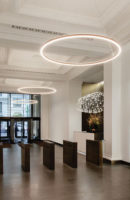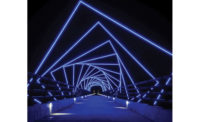There’s a growing trend to use LEDs not just as light sources but also as wireless data transmitters to address the problem of limited bandwidth in radio frequencies used by conventional WiFi networks. Potential applications for this exist in any public space where people tend to search for information on their mobile devices.
One technology central to the trend, called light fidelity—or LiFi, if you will—embeds data in light waves instead of radio waves. And as LEDs are semiconductors, the brightness of their illumination can be modulated to create a signal that special receiving devices can interpret as data.
In addition to LEDs, LiFi can also work with daylight—including direct sunlight. In fact, a pioneer in the technology, Edinburgh, Scotland-based Pure LiFi, has developed and tested receivers outdoors under 77,000 lux of sunlight. Because LiFi relies on detecting rapid changes in light’s intensity, its signal strength is not affected by daylight’s slower, gradual changes. Instead, the near-constant level of the sun’s brightness is filtered out by a LiFi receiver, which keeps the data stream intact.



